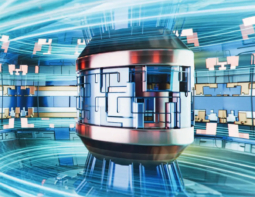
A new closed-loop microscopy technique that can detect chemical compositions at the nanoscale and at high sensitivity has been unveiled by Rohit Bhargava and colleagues at the Beckman Institute for Advanced Science and Technology at the University of Illinois. Their design relies on a piezoelectric material that responds to the voltages produced when a sample is probed by a cantilever. Their approach could enable researchers to precisely measure the spectra of a wide range of nanomaterials, including molecular-scale biological samples.
Based on atomic force microscopy (AFM), AFM-IR involves firing an infrared (IR) laser at a sample, then measuring the resulting thermal expansion using the sharp cantilever tip of an AFM. This is a very useful measurement because the thermal response of a material is characteristic of its chemical composition.
AFM-IR is now widely used to study the spectra of nanomaterials, but still faces a major challenge in dealing with unknown sources of vibrational noise in the cantilever, which can overwhelm the signal. This had been addressed by placing samples on specialized substrates or using specialized sample preparation methods – but these solutions tend to limit the versatility of the technique.

Closed-loop system
In their study, Bhargava’s team addressed the noise issue by placing a piezoelectric material under the substrate, which changed shape when a voltage was applied to it. In this case, the voltage was determined by the movements of the cantilever. Therefore, the change in shape of the piezoelectric offset the expansion of the irradiated sample, creating a closed-loop system that eliminated the cantilever’s movement. This meant that the chemical composition of the sample could be measured by monitoring the voltage applied to the piezoelectric, while any noise-inducing vibrations were minimized.

AFM detects heteroatoms in graphene nanoribbons
With a standard, commercial AFM-IR instrument, Bhargava and colleagues used their closed-loop approach to measure the composition of a 100 nm-thick acrylic film placed onto a glass substrate. Then, they repeated the measurement using a gold substrate. In each case, their results agreed well with spectroscopic measurements made with other techniques. The team also created accurate maps of localized infrared absorption in a 4 nm-thick acrylic film when applied to silicon, with little contribution from effects outside the closed loop. Since glass and silicon are both popular choices of substrate for nanomaterials researchers, the demonstrated versatility of the approach could remove the need for strict preparation measures.
Bhargava’s team now hopes that the sensitivity of their closed-loop approach will allow AFM-IR to analyse a far more diverse range of materials, with far smaller volumes. If applied, it could allow researchers to probe materials including the complex mixtures present in cell membranes, and behaviours including the deformation of protein molecules.
The new technique is described in Nature Communications.



